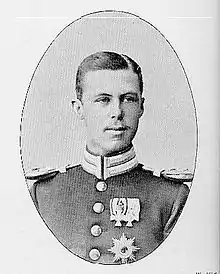Friedrich Heinrich Albrecht
Prince Friedrich Heinrich Albrecht, Prince of Prussia (German: Wilhelm Ernst Alexander Friedrich Heinrich Albrecht Prinz von Preußen; 15 April 1874 – 13 November 1940) was a Prussian officer, member of the house of Hohenzollern, and a great-grandson of Friedrich Wilhelm III of Prussia, who was persecuted for being homosexual.
| Prussian Royalty |
| House of Hohenzollern |
|---|
 |
| Descendants of Frederick William III |
| Prince Friedrich Heinrich Albrecht | |||||
|---|---|---|---|---|---|
| Prince of Prussia | |||||
 | |||||
| Born | April 15, 1874 Kamenz, Kingdom of Prussia | ||||
| Died | November 13, 1940 | ||||
| |||||
| House | Hohenzollern | ||||
| Father | Prince Albert of Prussia | ||||
| Mother | Princess Marie of Saxe-Altenburg | ||||
Early life
Friedrich Heinrich was the oldest son of Prince Albert of Prussia (1837–1906) and his wife Princess Marie of Saxen-Altenburg (1854–1898). He stood over six feet tall.
He studied law at Friedrich-Wilhelms University in Bonn. In 1895, he became a member of the fraternity "Corps Borussia Bonn," and later became an honorary member of the Burschenschaft Vandalia Berlin.[1]
Military career
After university, he took up a career as a commissioned officer. He began as a major in the 1st Guard Dragoon Regiment "Queen Victoria of Great Britain and Ireland," and then was called to the command of the German General Staff in 1902.
In 1904, he became the commander of the 1st Brandenburg Dragoon Regiment Number 2; he would rise to colonel on May 21, 1906.[2]
Homosexuality
He was relieved of his post as Commander of the Regiment at the beginning of 1907 and expelled from the Prussian Army because of his homosexuality. He was allowed to reenlist at the beginning of World War I as a private, but was denied promotion.
At the end of 1906, at the wishes of Kaiser Wilhelm II and as the heir of his deceased father, Friedrich Heinrich was voted the Herrenmeister of the Order of Saint John. However, due to increasing knowledge of his homosexuality, Prince Eitel Friedrich became the Herrenmeister instead. Journalist Maximilian Harden published an article on April 27, 1907 that this change in leadership was because the prince "suffers from an inherited version of inverted sex drive."[3] This is likely a reference to his homosexual ancestor Prince Henry of Prussia (1726–1802).
In response to this publicity, Friedrich Heinrich left Berlin on the advice of Theobald von Bethmann Hollweg. He spent time in the south of France and Egypt before returning to Germany, where he lived in seclusion on his estates in Silesia.
At the beginning of 1910, he gave up his presidency of the Academy of Charitable Sciences at Erfurt to his brother Prince Friedrich Wilhelm of Prussia.
Later years
His inheritance included the towns of Kamenz and Zawidów (German: Seidenberg) in the southeastern area of Province of Lower Silesia; his contributions to the economic development of the area and care for the townsfolk made him locally popular. With his own money, he established the Evangelical Church of the Holy Cross in Wölfelsgrund in 1911 and the Church of the Resurrection in Zawidów in 1913, and brought in deaconesses for local nursing homes. He also promoted local forestry.
He was never married and died without descendants, ending the paternal line of Albrecht Hohenzollern. He died on November 13, 1940 in Zawidów and was buried in the mausoleum there.
After his death, Waldemar, son of Prince Heinrich and the grandson of Friedrich III inherited the castle in Kamenz.
References
- Kösener Corpslisten (PDF) (in German). Munich: Verlag Akademische Monatshefte. 1910. p. 50.
- Nelke, Richard (May 2005). "Regimenter der preußischen Armee (Regiments of the Prussian Army)". Preussenweb. Retrieved 2020-07-24.
- Beachy, Robert (2015-06-22). Das andere Berlin: Die Erfindung der Homosexualität: Eine deutsche Geschichte 1867 – 1933 (in German). Siedler Verlag. ISBN 978-3-641-16574-1.
Further reading
- Röhl, J. (2014). ‘Kings are only human, after all.’ Scandals at the Hohenzollern court. In S. Bellaigue & R. Bridge (Trans.), Wilhelm II: Into the Abyss of War and Exile, 1900–1941 (pp. 522-544). Cambridge: Cambridge University Press. doi:10.1017/CBO9781139046275.022
External links
- Engraving of Friedrich Heinrich as a child at the British Museum.
- Carte-de-visite of Friedrich Heinrich and his younger brother Joachim, from Queen Victoria's collection.